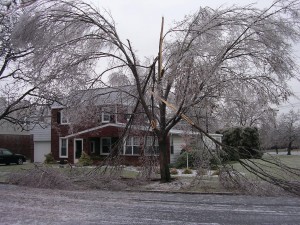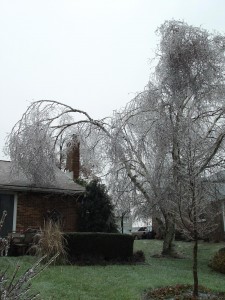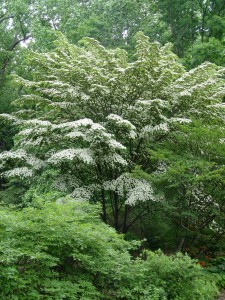Muscle Trees
April 24th, 2008
Now that winter’s ice storms are a mere gruesome memory, it’s time to think tree replacement.
Thousands of landscape trees cracked apart and lost limbs during the ice-capades of winter ’07-’08.
The next few weeks are ideal for planting new ones.
Tomorrow isn’t Arbor Day by accident, you know.
First, don’t get too paranoid over what happened this past winter. Those were some of the worst ice storms we’ve had in 30 years, so if your trees got through them, that’s a good sign.
“I had calls from people who wanted me to take down all the big trees around their house,” said Bob Good, owner of Good’s Tree Care in New Cumberland and Hershey. “That isn’t necessary. We have to keep in mind that this was a rare occurrence.”
Second, don’t make your new-tree decision solely on what trees are least likely to run into storm damage.
Yes, some species are more storm-resistant than others. But no, that doesn’t mean you should plant just any of those on any site you’ve got.
You still need to start with species that are suited to the soil, sunlight, moisture levels and other conditions where you’re planting.
It’s also smart to look for trees that have other good traits that match the site, such as drought-resistance, bug- and disease-resistance, a height that won’t jeopardize power lines and so on.
It’s fine to make storm-sturdiness one of your priorities. Just don’t let it be the only one.
Remember, even an otherwise storm-sturdy white oak could topple if you plant it in soggy clay.
Planting more storm-resistant trees could save us a lot of grief, though.
The bulk of our electric-power losses are due to trees and limbs falling on the lines.
Even though last winter’s fiasco was rare, Harrisburg averages four to five days a year with some icing. Biggies like last December occur roughly once every 20 years, according to the National Weather Service.
We also get our share of thunderstorms, hurricane remnants and wind gusts that wreak havoc on trees.
The University of Illinois has done some excellent research into what causes trees to fail in storms.
Turns out a lot has to do with the growth habit of particular species.

A nasty ice storm cracked apart Rich Wengert's Chinese elm tree in Lebanon. This one survived, but it lost about a third of its limbs.
Illinois researchers found, for instance, that species with broad crowns and long branches (i.e. elm, hackberry, ash and honeylocust) are much more likely to crack under ice load than more pyramidal trees with shorter, stockier branches (i.e. ginkgo, stewartia, black walnut, Kentucky coffee tree and most evergreens).
Trees such as sweetgum and tulip poplar, which start out more upright, become more prone to breaking as they age and widen out.
The Illinois researchers also found that some trees have much stronger branch attachments than others. ‘Bradford’ pears, white pines, red maples and white birch are among the weaker-branched species that readily cracked apart here this past winter, while crabapples, dogwoods, hornbeams and sweetgums came out virtually unscathed.
Trees that produce a lot of narrow-angled, V-shaped connections are particularly prone to splitting. Judicious pruning in the early years can counteract much of that.
Also related to branch strength is how fast a particular tree grows.
Fast growers tend to produce less dense wood and so are more prone to break apart.
It was no coincidence that poplars, willows and silver maples suffered some of our worst damage this past winter.
Unfortunately, many tree-buyers put fast growth at the top of their wish list.
Says Eric Vorodi, owner of About Trees Consulting in Boiling Springs: “If I had a nickel for every time I heard someone say, ‘I’ll never see shade from that in my lifetime.’ When you even mention the idea of a slow-growing tree, people cross it off the list right away.”
Bob Carey, a Hampden Twp. arborist and host of the “Garden Talk” radio show on Carlisle’s WIOO-1000AM, says people don’t help by fertilizing trees way more than they should.
That, too, encourages too-fast growth, not to mention unnecessary pruning work.
“Plants that tend to grow more slowly and that are not pushed by fertilizer are the ones that tend to be strongest,” Carey says. “We seem to struggle to get them to grow and then struggle to get them to stop growing.”
Some tree species just have more flexible wood than others.
Lower Paxton Twp. gardener and horticulturist David Wilson points to the limber pine that has such flexible wood that “you could bend shoots and light branches into a loop and they won’t break.”

This birch sagged but didn't break. Its wood is relatively flexible.
In the December storm, Good saw some river birches that nearly sagged to the ground but sprang back when the ice melted.
The same happened with species such as beech, bald cypress, Norway spruce, arborvitae, hemlock, Douglas fir and blue atlas cedar. Most of these bent but didn’t snap.
The accompanying list offers some of the best “muscle trees” that have good all-around storm strength.
Don’t forget… that’s just one factor.
Fifteen good “muscle trees” that hold up well in storms:
* Blackgum or black tupelo (Nyssa sylvatica). Large native deciduous shade tree with brilliant scarlet fall foliage. 40-50 feet tall, 20-30 feet wide. Full sun to part shade.
* Shagbark hickory (Carya ovata). Large native deciduous shade tree with edible nuts, “shaggy” bark and yellow fall foliage. 60-80 feet tall and wide. Sun to light shade.
* American hornbeam (Carpinus caroliniana). Mid-sized native deciduous tree with serrated leaves that turn yellow-orange in fall. 20-30 feet tall and wide. Sun to part shade.
* Norway spruce (Picea abies). Needled evergreen with gently arching habit. Grows 50 feet tall by 15-20 feet wide in full sun.
* Ginkgo biloba. Upright deciduous tree with fan-shaped leaves and yellow fall foliage. Grows 40-50 feet tall in full sun to light shade. Plant males only.
* White oak (Quercus alba). Large but slow-growing native deciduous shade tree with deep-red fall foliage and 1-inch brown acorns. 60-80 feet tall and wide. Full sun.
* Bald cypress (Taxodium distichum). Native conifer with short green needles that turn pumpkin-orange in fall before dropping. Very tolerant of wet soil. 50-70 feet tall and wide. Full sun.
* Stewartia (Stewartia pseudocamellia, koreana). Slow-growing ornamental tree with white early-summer flowers, spectacular fall foliage and peeling bark. 20-25 feet tall, 16-18 feet wide. Full sun to light shade.

Kousa dogwood is a strong-wooded species.
* Kousa dogwood (Cornus kousa). Slow-growing ornamental tree with white or pink late-spring flowers and red-orange fall fruits. 25 feet tall, 18 feet wide. Sun or part shade.
* Crabapple (Malus). Small ornamental tree with white, pink or rose spring flowers and red or orange fall fruits. ‘Prairifire’ and ‘Sugar Tyme’ are two of the best. 16 to 18 feet tall and wide. Full sun.
* Blue atlas cedar (Cedrus atlantica). Blue-needled evergreen with narrow open habit that widens with age. Nice specimen. Ultimately 40 feet tall, 30 feet wide in full sun to light shade.
* Bur oak (Quercus macrocarpa). Large native deciduous tree with scalloped leaves that turn yellow in fall and fringed acorns. 70-80 feet tall and wide. Full sun.
* Douglas fir (Pseudotsuga menziesii). Fast-growing, green-needled evergreen with mild citrus scent. 50 feet tall, 14-16 feet wide. Full sun to light shade.
* Hophornbeam (Ostrya virginiana). Durable small native tree with small nutlets and yellow fall foliage. Tolerant of damp soil. 25-35 feet tall and wide. Sun to part shade.
* Witch hazel (Hamamelis). Small ornamental tree with very early orange or yellow flowers and neon gold or yellow fall foliage. 15-20 feet tall and wide. Full sun to part shade.
Ways to minimize storm damage
No matter which species you pick, minimize storm damage through good planting and cultural practices, such as:
* Improve the soil with compost to reduce compaction and to aid drainage.
* Plant so the root flare (the widened base of the trunk just above the roots) is above grade.
* Fray out any circling roots before planting. Remove burlap before filling the hole.
* Don’t stake unless necessary. If you do, use wide bands – not wire or rope – and remove staking within 1 year.
* Use 3 inches of bark mulch in a minimum 6-foot diameter mulched area around the tree. Keep mulch 2 to 3 inches away from the trunk. Never pile it onto the base.
* Water often enough to keep the soil consistently damp just below and all around the rootball but never so much that it’s soggy. One good soaking every 5 to 7 days is better than daily watering.
* There’s usually no need to fertilize a new or mature tree. Too much is as bad as not enough. Base fertilizer on what a soil test recommends.
* After the first year, begin pruning lightly to shape the tree, to eliminate weak or competing attachments and to remove excess and crossing branches.







